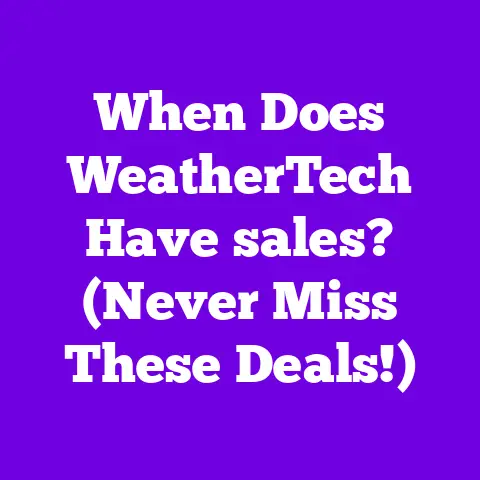When Are End-of-Season sales? (Don’t Miss Clearance!)
As I look around my home and wardrobe each season, I feel the familiar itch to refresh things.
Whether it’s swapping out heavy winter coats for breezy spring jackets, transitioning from dark, cozy home decor to bright, airy accents, or upgrading my camping gear for summer adventures, the changing seasons always spark a desire for something new.
But let’s be honest, keeping up with these seasonal shifts can put a strain on my wallet.
I want to embrace the new season without completely emptying my bank account.
I’m not alone in this.
Millions of people share this desire to update their lives with each passing season, and the financial aspect is a significant consideration.
We want the latest styles, the best gadgets, and the most comfortable home environments, but we also want to be smart about our spending.
That’s where the thrill of the hunt comes in – the anticipation of finding incredible deals during end-of-season sales.
The allure of snagging a high-quality item at a fraction of its original price is undeniable.
It’s a win-win situation: I get to satisfy my need for something new, and I do it without breaking the bank.
The excitement builds as I anticipate the arrival of these sales, knowing that with a little planning and savvy shopping, I can transform my wardrobe, home, or outdoor gear for a fraction of the cost.
So, let’s dive into the world of end-of-season sales and uncover the secrets to maximizing your savings in 2025.
Section 1: Understanding End-of-Season Sales
End-of-season sales are essentially clearance events that retailers host to clear out their inventory of products that are specific to a particular season.
Think of it as a strategic move to make room for new arrivals and stay ahead of the ever-changing consumer trends.
Retailers like Nordstrom, Target, and Amazon use these sales to reduce overstock, free up warehouse space, and generate revenue on items that are no longer in high demand.
The reason retailers implement these sales is simple: it’s a business necessity.
Holding onto seasonal inventory ties up capital and can lead to losses if the items don’t sell before the next season rolls around.
By offering significant discounts, retailers incentivize consumers to purchase these items, creating a win-win situation for both the seller and the buyer.
To understand when these sales occur, it’s essential to grasp the seasonal retail calendar.
While the exact timing can vary depending on the retailer and the product category, here’s a general overview:
- Winter Sales: Typically begin immediately after the holiday season in January and continue through February and March.
This is when retailers clear out winter apparel, holiday decorations, and cold-weather gear. - Spring Sales: Start in April and May as retailers transition from winter to summer products.
Expect to see discounts on spring apparel, home goods, and outdoor equipment. - Summer Sales: Occur in July and August, often coinciding with back-to-school promotions.
Retailers clear out summer apparel, swimwear, and outdoor gear. - Fall Sales: Begin in September and October as retailers prepare for the holiday season.
This is when you’ll find discounts on summer items and early fall apparel.
The psychology behind shopping during these sales is fascinating.
The feeling of urgency plays a significant role.
Retailers often use phrases like “limited time offer” and “while supplies last” to create a sense of scarcity, prompting consumers to make quick decisions.
The excitement of finding a great deal also contributes to the shopping frenzy.
According to a study by RetailMeNot, 60% of consumers say that finding a good deal is the most exciting part of shopping.
Section 2: The 2025 Retail Calendar
Alright, let’s get down to the specifics.
I’ve done some digging, and here’s a detailed timeline of when I expect end-of-season sales to hit in 2025, broken down by season:
Winter Sales (January – March):
- January: The post-holiday clearance extravaganza.
Expect discounts of up to 70% on winter apparel, holiday decorations, and electronics.
Retailers like Macy’s and Kohl’s are known for their deep discounts during this period.
For instance, in January 2024, Macy’s offered up to 75% off clearance items. - February: President’s Day sales often overlap with winter clearance.
Look for deals on furniture, mattresses, and appliances.
Home Depot and Lowe’s typically offer significant discounts on these items. - March: Final winter clearance events.
Retailers are eager to clear out remaining winter inventory to make room for spring collections.
This is a good time to snag heavily discounted winter apparel and accessories.
- January: The post-holiday clearance extravaganza.
Spring Sales (April – May):
- April: Transition from winter to spring.
Clearance sales on winter apparel continue, but you’ll also start seeing discounts on spring apparel and home goods.
Easter sales often fall in this period. - May: Memorial Day sales mark the unofficial start of summer and offer discounts on outdoor furniture, grills, and gardening supplies.
Expect retailers like Wayfair and Overstock to offer significant discounts.
- April: Transition from winter to spring.
Summer Sales (June – August):
- June: Early summer sales on swimwear, sandals, and outdoor gear.
- July: Mid-summer sales events, often coinciding with Fourth of July promotions.
Look for discounts on summer apparel, home goods, and electronics.
Amazon’s Prime Day usually falls in July and offers exclusive deals for Prime members.
In 2023, Amazon’s Prime Day generated over $12 billion in sales worldwide. - August: Back-to-school sales.
Discounts on school supplies, backpacks, and apparel.
Retailers like Target and Walmart offer competitive prices during this period.
Fall Sales (September – November):
- September: End-of-season sales for summer items.
Retailers clear out swimwear, sandals, and outdoor gear to make room for fall collections. - October: Early fall sales leading into the holiday season.
Discounts on fall apparel, home decor, and electronics. - November: Black Friday and Cyber Monday.
The biggest shopping events of the year, offering significant discounts on a wide range of products.
According to the National Retail Federation (NRF), Black Friday sales in 2023 reached $98 billion.
- September: End-of-season sales for summer items.
Notable Events:
- Black Friday (November 28, 2025): The day after Thanksgiving is the biggest shopping day of the year.
Expect massive discounts on electronics, appliances, apparel, and more. - Cyber Monday (December 1, 2025): The Monday after Thanksgiving is the online equivalent of Black Friday.
Look for exclusive online deals and free shipping offers. - Amazon Prime Day (July – Exact Date TBD): A two-day shopping event exclusively for Amazon Prime members.
Offers significant discounts on a wide range of products.
Important Considerations:
- These dates are based on historical trends and may vary slightly depending on the retailer and the product category.
- Be sure to sign up for email newsletters and follow your favorite retailers on social media to stay informed about upcoming sales events.
Section 3: Popular Retailers and Their Sales Events
Now, let’s talk about the big players.
I’ve compiled a list of major retailers known for their end-of-season sales in 2025, along with insights into their typical sales strategies:
Online vs. Brick-and-Mortar Sales:
Online retailers often offer more frequent and aggressive discounts than brick-and-mortar stores.
This is because they have lower overhead costs and can reach a wider audience.
However, brick-and-mortar stores often offer the advantage of being able to see and touch the products before you buy them.
Additionally, brick-and-mortar stores may offer in-store-only deals that are not available online.
Section 4: Tips for Maximizing Savings During End-of-Season Sales
Alright, now for the good stuff – how to make sure you’re getting the absolute best deals.
I’ve learned a few things over the years, and here are some strategies that I’ve found helpful:
- Plan Ahead: The key to successful sale shopping is to plan ahead.
Before the sales even begin, take inventory of your wardrobe, home, and outdoor gear.
Identify what you need and create a shopping list.
This will help you stay focused and avoid impulse purchases. - Set a Budget: It’s easy to get carried away during sales, so it’s important to set a budget and stick to it.
Determine how much you’re willing to spend and make sure you don’t exceed that amount. - Do Your Research: Before making a purchase, take the time to research the product you’re interested in.
Read reviews, compare prices, and check for any potential issues.
This will help you make an informed decision and avoid buyer’s remorse. - Use Technology: Take advantage of technology to track sales and compare prices.
There are numerous apps and websites that can help you find the best deals.
Some popular options include:- Honey: A browser extension that automatically finds and applies coupon codes.
- RetailMeNot: A website and app that provides access to coupons and deals from thousands of retailers.
- CamelCamelCamel: A website that tracks the price history of products on Amazon.
- Sign Up for Email Newsletters: Many retailers offer exclusive discounts and early access to sales for email subscribers.
Sign up for the newsletters of your favorite retailers to stay informed about upcoming sales events. - Follow Retailers on Social Media: Retailers often announce sales and promotions on their social media channels.
Follow your favorite retailers on Facebook, Instagram, and Twitter to stay up-to-date on the latest deals. - Be Patient: Sometimes, the best deals come later in the sale cycle.
If you’re not in a hurry, wait a few days or weeks to see if the price drops further. - Read the Fine Print: Before making a purchase, be sure to read the fine print.
Pay attention to the return policy, shipping costs, and any other restrictions.
Section 5: The Impact of Economic Trends on End-of-Season Sales
The economic climate in 2025 will undoubtedly play a significant role in shaping end-of-season sales.
Factors like inflation rates, consumer confidence, and supply chain issues can all impact pricing strategies, inventory levels, and consumer behavior.
- Inflation Rates: If inflation remains high in 2025, retailers may be forced to raise prices, even during sales events.
This could lead to consumers being more cautious about their spending and seeking out deeper discounts. - Consumer Confidence: Consumer confidence is a key indicator of economic health.
If consumer confidence is high, people are more likely to spend money, even during periods of inflation.
However, if consumer confidence is low, people may cut back on discretionary spending and focus on essential items. - Supply Chain Issues: Supply chain disruptions can lead to inventory shortages and higher prices.
If supply chain issues persist in 2025, retailers may have difficulty stocking their shelves, which could limit the availability of discounted items during sales events.
According to a report by Deloitte, “The retail industry is expected to face continued headwinds in 2025 due to ongoing economic uncertainty.” The report also notes that “consumers are becoming more price-sensitive and are increasingly seeking out value-driven options.”
These trends could lead to retailers offering more aggressive discounts during end-of-season sales to attract price-conscious consumers.
However, they may also face challenges in maintaining profitability due to higher costs and supply chain disruptions.
Conclusion
As I look ahead to 2025, I’m already feeling the excitement building for the upcoming end-of-season sales.
The opportunity to refresh my wardrobe, home, and outdoor gear at discounted prices is something I always look forward to.
But more than just the thrill of the deal, it’s about the satisfaction of knowing I’m making smart financial decisions while still enjoying the things I love.
The key takeaway here is awareness.
By understanding the timing of these sales, knowing which retailers to watch, and employing effective shopping strategies, I can maximize my savings and make the most of these opportunities.
And with the potential impact of economic trends in mind, I’m prepared to be even more strategic in my approach.
So, I’m marking my calendar, preparing my shopping list, and getting ready to dive into the world of end-of-season sales in 2025.
The potential for significant savings is there, and I’m determined to make the most of it.
I hope you are too!






